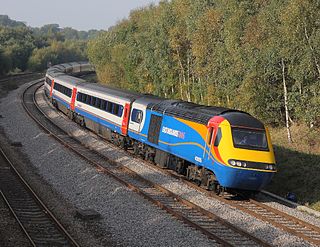
The Midland Main Line is a major railway line in England from London to Nottingham and Sheffield in the north of England. The line is under the Network Rail description of Route 19; it comprises the lines from London's St Pancras station via Leicester, Derby/Nottingham and Chesterfield in the East Midlands.

Sheffield station, formerly Pond Street and later Sheffield Midland, is a combined railway station and tram stop in Sheffield, England, and the busiest station in South Yorkshire. Adjacent is Sheffield station/Sheffield Hallam University Sheffield Supertram stop. In 2017–18, the station was the 43rd-busiest in the UK, and the 15th-busiest outside London.

The Hope Valley line is a trans-Pennine railway line in England, linking Manchester with Sheffield. It was completed in 1894.

Totley Tunnel is a 6,230-yard tunnel under Totley Moor, on the Hope Valley line between Totley on the outskirts of Sheffield and Grindleford in Derbyshire, England.

York railway station is on the East Coast Main Line in the United Kingdom, serving the city of York, North Yorkshire. It is 188 miles 40 chains (303.4 km) north of London King's Cross and on the main line it is situated between Doncaster to the south and Thirsk to the north. As of June 2018, the station is operated by London North Eastern Railway.

Meadowhall Interchange is a transport interchange located in north-east Sheffield, consisting of a combined heavy rail station, tram stop and bus and coach station. The second-busiest heavy rail station in the city in terms of passenger numbers, Meadowhall Interchange provides connections between National Rail services, the Sheffield Supertram light rail network, intercity coach services and the city bus network.

Chesterfield railway station serves the town of Chesterfield in Derbyshire, England. It lies on the Midland Main Line. Four tracks pass through the station which has three platforms. It is currently operated by East Midlands Railway.
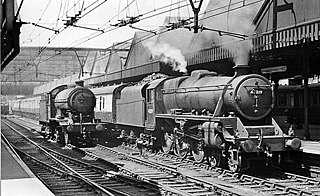
Sheffield Victoria was the main railway station in Sheffield, Yorkshire, England, on the Great Central Railway, between Chesterfield and Penistone.

The Cowburn Tunnel is a railway tunnel at the western end of the Vale of Edale in the Derbyshire Peak District of England. The tunnel is 3,702 yards (3,385 m) long.
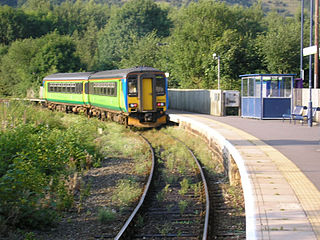
Ambergate railway station is a railway station owned by Network Rail and managed by East Midlands Railway. It serves the village of Ambergate in Derbyshire, England. The station is located on the Derwent Valley Line from Derby to Matlock, which diverges from the Midland Main Line just south of the station at Ambergate Junction.

Edale railway station serves the rural village of Edale in the Derbyshire Peak District, in England. It was opened in 1894 on the Midland Railway's Dore and Chinley line, 20 miles (32 km) west of Sheffield and 22 miles (35 km) east of Manchester Piccadilly.

Hope railway station serves the villages of Hope and Brough in the Derbyshire Peak District of England, 14+3⁄4 miles (23.7 km) west of Sheffield.

Chinley railway station serves the village of Chinley in Derbyshire, England. The station is 17+1⁄2 miles (28.2 km) south east of Manchester Piccadilly, on the Hope Valley Line from Sheffield to Manchester. It is unstaffed and is managed by Northern Trains.

Bamford railway station serves the village of Bamford in the Derbyshire Peak District, in England and is managed by Northern Trains. It is located 13 miles (21 km) west of Sheffield on the Hope Valley Line.

Grindleford railway station serves the village of Grindleford in the Derbyshire Peak District, in England, although the station is about a mile way, the nearest village being Nether Padley.

New Mills Central railway station serves the town of New Mills in Derbyshire, England. It is on the Hope Valley Line between Manchester Piccadilly and Sheffield, 12+3⁄4 miles (20.5 km) east of the former. The town is also served by New Mills Newtown station, which is on the Buxton to Stockport and Manchester line.
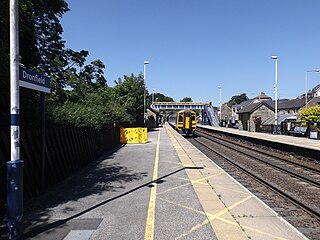
Dronfield railway station serves the town of Dronfield in Derbyshire, England, south of Sheffield, on the Midland Main Line between Chesterfield and Sheffield.
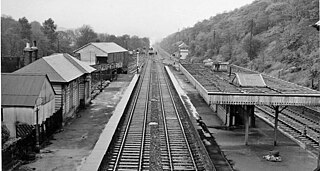
Beauchief railway station was in Sheffield, South Yorkshire, England.

Millhouses and Ecclesall railway station was a railway station in the Millhouses district of Sheffield, South Yorkshire, England.
The Sheffield District Rail Rationalisation Plan was a series of linked railway civil engineering projects, station and line closures and train route changes that took place in and around Sheffield, South Yorkshire. The majority of these changes took place in the 1960s and early 1970s, however the plan, by now much modified in the face of rapidly dwindling freight traffic, was not fully realised until the 1980s.




















